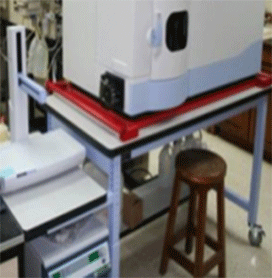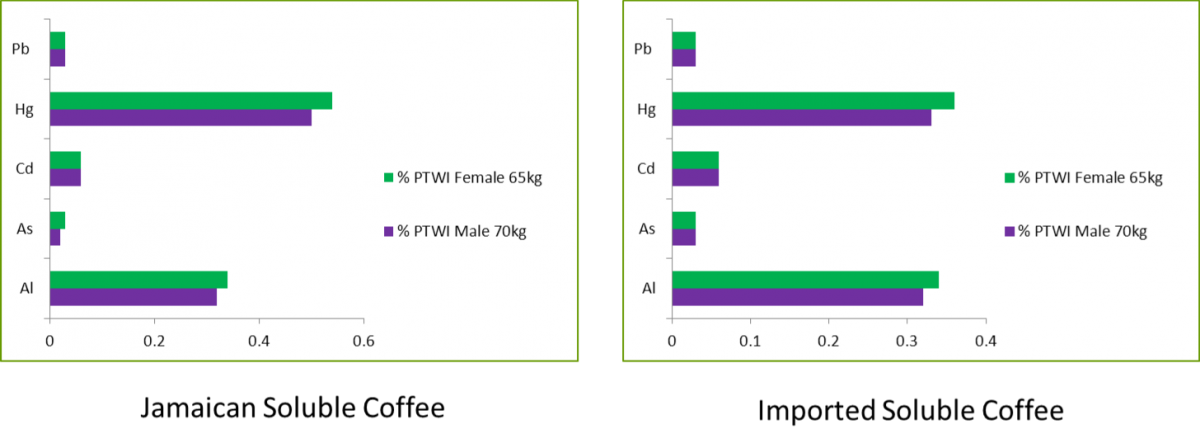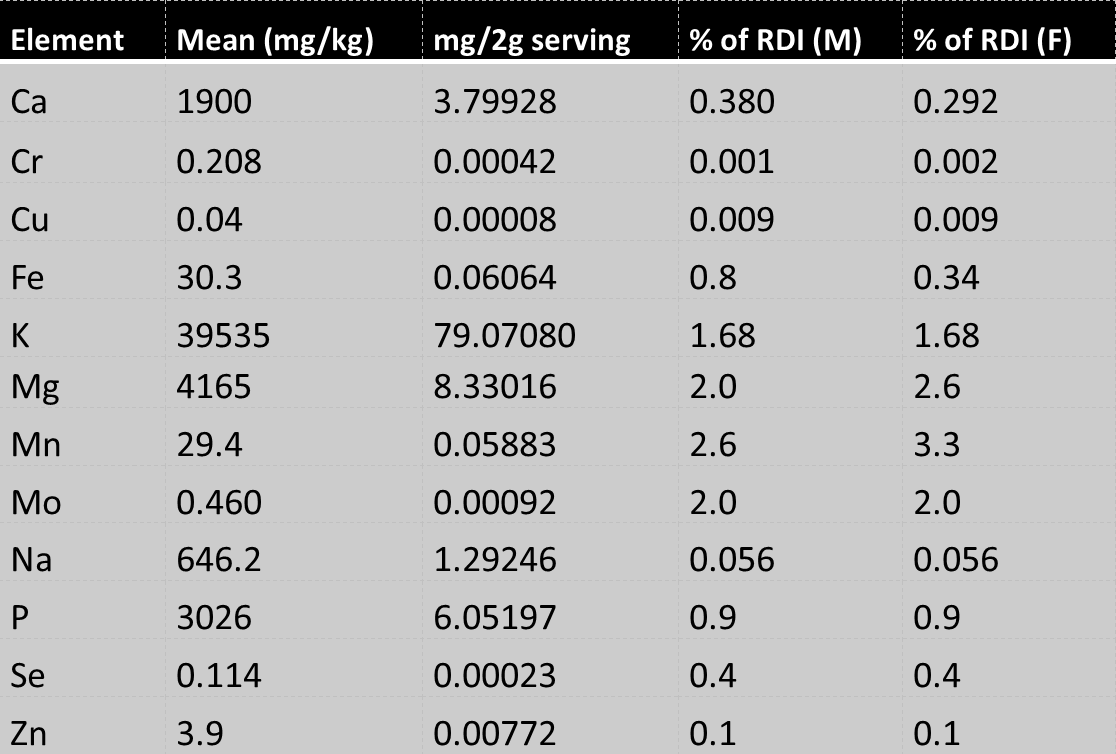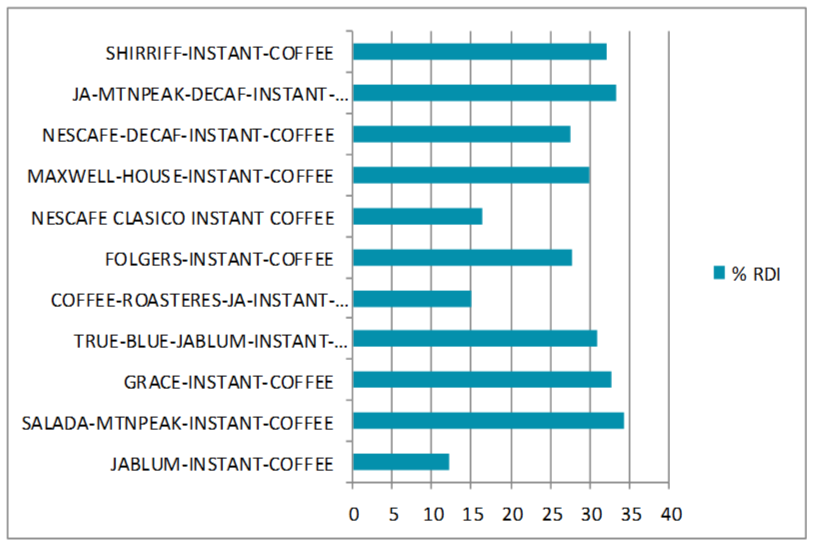

Jamaica, a net exporter of coffee, has in recent years seen the importation of soluble coffee increase from 16,872 kg in 2010 to 36,419 kg in 20131. With the expanded local market for soluble coffee and its products and a significant portion of this demand being supplied by importation the aim of the study was to determine dietary exposure of the Jamaican public to heavy metals and trace elements through consumption of soluble coffee.
 Eleven brands of soluble coffee sold on the Jamaican market were sampled. Of these, 6 were Jamaican soluble coffee (5 regular, 1 decaffeinated) and 4 were imported (3 regular, 1 decaffeinated). The final was Robusta variety coffee packaged by a local brand.
Eleven brands of soluble coffee sold on the Jamaican market were sampled. Of these, 6 were Jamaican soluble coffee (5 regular, 1 decaffeinated) and 4 were imported (3 regular, 1 decaffeinated). The final was Robusta variety coffee packaged by a local brand.
Fig. 1 Analytical Techniques used in Coffee Analysis
Al, As, Ba, Br, Ca, Ce, Co, Cs, Eu, Hg, K, La, Mg, Mn, Na, Rb, Sb, Sc, Se, Sm, and Th were determined using Instrumental Neutron Activation Analysis (INAA); Cd and Pb were determined using Graphite Furnace Atomic Absorption Spectrophotometry (GF-AAS); Cr, Cu, Fe, Mo, Ni, P, Sr and Zn were determined using Inductively Coupled Plasma Optical Emission Spectroscopy (ICP-OES).
 Samples were categorised as Jamaican, imported, decaffeinated and robust to obtain mean values. A serving size of 2g of soluble coffee powder was used to estimate dietary intake of essential elements and exposure to potentially toxic elements. The intake in mg was used to calculate the Provisional Tolerable Weekly Intake (PTWI) for potentially toxic elements as well as the recommended Daily Intake (RDI) for essential elements for both men and women. All samples had measurable aluminum. The contribution of a single serving to the PTWI2 is less than 0.5% in all cases. The contribution to the PTWI (0.015 mg/kg bw3) of inorganic arsenic would still be less than a percent if the results total arsenic content was assumed to be inorganic. No soluble coffee examined would contribute significantly to the PTWI of 0.007 mg/kg bw. A serving of the only soluble coffee with measurable levels of lead, 0.04% to the PTWI (0.05 mg/kg bw). Fig. 2% PTWI (Jamaican and Imported Soluble Coffee)
Samples were categorised as Jamaican, imported, decaffeinated and robust to obtain mean values. A serving size of 2g of soluble coffee powder was used to estimate dietary intake of essential elements and exposure to potentially toxic elements. The intake in mg was used to calculate the Provisional Tolerable Weekly Intake (PTWI) for potentially toxic elements as well as the recommended Daily Intake (RDI) for essential elements for both men and women. All samples had measurable aluminum. The contribution of a single serving to the PTWI2 is less than 0.5% in all cases. The contribution to the PTWI (0.015 mg/kg bw3) of inorganic arsenic would still be less than a percent if the results total arsenic content was assumed to be inorganic. No soluble coffee examined would contribute significantly to the PTWI of 0.007 mg/kg bw. A serving of the only soluble coffee with measurable levels of lead, 0.04% to the PTWI (0.05 mg/kg bw). Fig. 2% PTWI (Jamaican and Imported Soluble Coffee)


Fig. 4 % RDI Per Serving of Jamaican Soluble Coffee Fig.5 % RDI Per Serving of Imported Soluble Coffee
Soluble coffee is known to be relatively enriched in several macronutrients including potassium, magnesium and phosphorus and moderately high in calcium and sodium4.
The process of coffee solubilization, also appears to result in low concentrations of elements such as copper and zinc5.
Potassium, magnesium, manganese and molybdenum are the only essential elements that contribute more than a percent to the RDI per serving of soluble coffee analyzed.
Rubidium has not been established as essential but soluble coffee is a significant source (see Fig. 7).


Soluble coffees are not a significant dietary source of heavy metals.
The dietary intake of most essential elements from a serving of soluble coffee is also negligible.
Only high consumption would contribute significantly to the RDI of potassium, magnesium, manganese and molybdenum.
Significant source of Rubidium
[1] Coffee Industry Board of Jamaica. 2014. Coffee Industry Board of Jamaica Annual Report and Statement 324 of Accounts 2012-2013
[2] Joint FAO/WHO Expert Committee on Food Additives. 2010. Evaluation of Certain Food Additives and Contaminants: Seventy-second Report of the Joint FAO/WHO Expert Committee on Food Additives. WHO Technical Series No. 959. World Health Organization/Joint FAO/WHO Expert Committee on Food Additives, Geneva, Switzerland
[3] World Health Organization. 2015. Micronutrient deficiencies: Iron deficiency anaemia. Available at: http://www.who.int/nutrition/topics/ida/en/
[4] Oliveira M, Casal S, Morais S, Alves C, Dias F, Ramos S, Mendes E, Delerue-Matos C, Oliveira BPP. 2012. Intra- and interspecific mineral composition variability of commercial coffees and coffee substitutes. Contribution to mineral intake. Food Chem. 130:702–709.
[5] Fernandes AP, Santos MC, Lemos SG, Ferreira MMC, Nogueira AA, Nobrega JA. 2005. Pattern recognition applied to mineral characterization of Brazilian coffees and sugar-cane spirits. Spectrochimica Acta Part B. 60:717- 724.